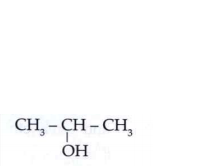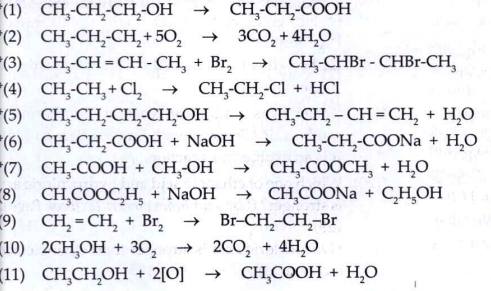Complete Solutions to Answer the following of chapter CARBON COMPOUNDS of Class 10 book with complete answers and questions
| Class 10 | CHEMISTRY |
| Chapter | CARBON COMPOUNDS |
| TARGET PUBLICATION | Answer the following |
| Number Of Questions | 100 |
| Academic Year | 2023-24 |
Write the number of covalent bonds in the molecules of butane, `C_(4)H_(10)`.
02:16View SolutionExplain the stpes to draw structural formula of ethane.
02:45View SolutionDraw an electron-dot structure of the following molecules (without showing the circles).
i. Methane02:58View SolutionDraw an electron-dot structure of the following molecules (without showing the circles).
ii. Ethene03:33View SolutionDraw an electron-dot structure of the following molecules (without showing the circles).
iii. Methanol03:17View SolutionDraw an electron-dot structure of the following molecules (without showing the circles).
iv. Water02:56View SolutionWrite the molecular formulae and draw electron-dot structures of the following compounds :
i. Ethane05:02View SolutionAnswer the following questions: Draw an electron dot structure of the following molecules: Ethene
04:11View SolutionExplain the term with example : Unsaturated hydrocarbon
02:40View SolutionWhat is the difference between satureated hydrocarbons and unsaturated hydrocarbons ?
04:21View SolutionWrite a short note on : Crude oil
View SolutionExplain the term with example : Structural isomerism
03:14View SolutionDraw all possible structural formulae of compounds from their molecular formulae given below.
i. `C_(3)H_(8)`02:35View SolutionDraw all possible structural formula of compounds from their molecular formula given below: `C_4H_(10)`
02:19View SolutionDraw all possible structural formulae of compounds from their molecular formulae given below.
iii. `C_(3)H_(4)`02:11View SolutionWrite the molecular formula of the following :
i. Hexane03:46View SolutionWrite the molecular formula of the following :
ii. Cyclohexane03:43View SolutionDraw electron dot structure of cyclohexane.
05:22View SolutionSaturated hydrocarbons are classified into three types. Write these names giving one example each.
02:30View SolutionExplain the structure of benzene .
View SolutionDefine the following : Hetero atom in a carbon compound
02:07View SolutionExplain the term with example : Functional group
02:22View SolutionWrite the name of each of the following functional group :
i. `-OH`02:59View SolutionWrite the name of each of the following functional group :
ii. `-underset(O)underset(||)C-`02:55View SolutionAnswer the following questions:
Give any four functional group containing oxygen as the heteroatom in it. Write name and structural formula and one example each.03:04View SolutionGive names of three functinal groups containing three heteroatoms, write names and structural formulae and one example each.
03:03View SolutionIdentify and name the functional groups present in the following compounds.
i. `H-overset(H)overset(|)underset(H)underset(|)C-overset(H)overset(|)underset(H)underset(|)C-overset(H)overset(|)underset(H)underset(|)C-OH`03:07View SolutionIdentify and name the functional groups present in the following compounds.
ii. `H-overset(H)overset(|)underset(H)underset(|)C-overset(H)overset(|)underset(H)underset(|)C-overset(O)overset(||)C-O-overset(H)overset(|)underset(H)underset(|)C-H`02:36View SolutionIdentify and name the functional groups present in the following compounds.
iii.`H-overset(H)overset(|)underset(H)underset(|)C-overset(H)overset(|)underset(H)underset(|)C-O-overset(H)overset(|)underset(H)underset(|)C-overset(H)overset(|)underset(H)underset(|)C-H`02:47View SolutionWith the help of an example explain what is mean by homologous series.
03:23View SolutionState the characteristics of a homologous series.
04:16View SolutionWrite the molecular formulae of the first two members of the homologous series having functional group, `-COOH.`
03:50View SolutionAnswer the following questions: By how many `-CH_2-` (methylene) units do the formulae and the fist two members of homologous series ofalkane, methane `(CH_4)` and ethane `(C_2H_6)` differ? Similarly, by how many `-CH_2-` Units do the neighboring members ethane `(C_2H_6)` and propane `(C_3H_8)` differ from each other?
04:45View SolutionHow many methylene units are extra in the formula of the fourth member than the third members of the homologous series of alcohols?
02:11View SolutionHow many methylene units are less in the formula of the second member than the third member of two homologous series of alkenes?
02:31View SolutionExplain the term with example : Alkane
02:28View SolutionWhat would be the general formula for the molecular formulae of the members of the homologous series of alkanes ? What would be the value of 'n' for the first member of this series ?
04:27View SolutionThe general molecular formula for the homologous series of alkynes is `C_(n)H_(2n-2)`. Write down the individual molecular formulae of the value 2, 3 and 4 respectively for 'n' in this formula.
02:44View SolutionComplete the following flowchart and write the general formula of alkane :
 View Solution
View SolutionState rules for the IUPAC nomenclature of carbon compounds. Give one example.
View SolutionHow would you name the following compounds ?
`H-overset(H)overset(|)underset(H)underset(|)C-overset(H)overset(|)underset(H)underset(|)C-overset(H)overset(|)underset(H)underset(|)C-overset(H)overset(|)underset(H)underset(|)C-C-=C-H`03:52View SolutionWrite the IUPAC names of the following compounds :
`H-overset(H)overset(|)underset(H)underset(|)C-overset(H)overset(|)underset(H)underset(|)C-overset(H)overset(|)underset(H)underset(|)C-overset(H)overset(|)underset(H)underset(|)C-overset(O)overset(||)C-O-H`03:26View SolutionWrite the IUPAC names of the following compounds :
`H-overset(H)overset(|)underset(H)underset(|)C-overset(H)overset(|)underset(H)underset(|)C-overset(H)overset(|)underset(H)underset(|)C-overset(H)overset(|)underset(H)underset(|)C-overset(H)overset(|)underset(H)underset(|)C-overset(H)overset(|)underset(H)underset(|)C-overset(H)overset(|)C=O`03:46View SolutionWrite the IUPAC names of the following compounds :
`H-overset(H)overset(|)underset(H)underset(|)C-overset(H)overset(|)underset(H)underset(|)C-overset(H)overset(|)underset(H)underset(|)C-overset(H)overset(|)underset(H)underset(|)C-overset(H)overset(|)underset(H)underset(|)C-O-H`02:20View SolutionWrite the IUPAC names of the following structural formulae.
`CH_(3)-CH_(2)-CH_(3)`02:20View SolutionWrite the IUPAC name of the following structural formula:
 02:33View Solution
02:33View SolutionWrite the IUPAC names of the following structural formula: `CH_3CH_2-COOH`
02:04View SolutionWrite the IUPAC names of the following structural formulae.
`CH_(3)-CH_(2)-NH_(2)`02:51View SolutionWrite the IUPAC names of the following structural formula: `CH_3-CHO`
02:42View SolutionWrite the IUPAC name of the following structural formula : `CH_3-CO-CH_2-CH_3`
01:41View SolutionWrite structural formulae for the following IUPAC names: Pentan-2-one Molecular formula-`C_5H_(10)O`
02:31View SolutionWrite structural formulae for the following IUPAC names: 2-Chlorobutane: Molecular formula `C_4H_9CI`
01:18View SolutionWrite structural formulae for the following IUPAC names: Propan-2-ol: Molecular formula-`C_3H_7OH`
02:07View SolutionWrite structural formulae for the following IUPAC names: Methanal Molecular formula- `CH_2O`
01:25View SolutionWrite structural formulae for the following IUPAC names: Butanoic acid: Molecular formula-`C_4H_8O_2` or `CH_3CH_2CH_2COOH`
02:17View SolutionWrite structural formulae for the following IUPAC names: 1-bromopropane: Molecular formula-`C_3H_7Br`
01:56View SolutionWrite structural formulae for the following IUPAC names: Ethanamine : Molecular formula-`C_2H_5_NH_2`
01:22View SolutionWrite structural formulae for the following IUPAC names: Butanone Molecular formula- `C_4H_8O`
01:55View SolutionAnswer the following questions in one word :
Which is the component of biogas that makes it useful as fuel.00:55View SolutionAnswer the following questions in one word :
Which product is formed by the combustion of elemental carbon?00:59View SolutionAnswer the following questions in one word :
Is the biogas comustion reaction endothermic or exothermic.01:49View SolutionAnswer the following questions in one word :
Propane `(C_3H_6)` is one of the combustible component of LPG. Write down the reaction for propane `(C_3H_8)`01:45View SolutionWhich of the following compounds will burn with a sooty flame?
04:21View SolutionThe gas stoves have inlets for air. Explain.
View SolutionDefine the following/write notes:
Oxidation Reaction02:39View SolutionExplain the following reactions with examples :
Combustion reaction02:21View SolutionDefine the following : Oxidant
01:45View SolutionHow is the transformation of ethanol into ethanoic acid an oxidation reaction?
02:08View SolutionDefine the following : Reduction
02:35View SolutionWhat is a catalyst? Write any one reaction which is brought about by use of a catalyst.
04:32View SolutionDifferentiate between: Saturated and unsaturated Hydrocarbons.
03:08View SolutionWhat is a substitution reaction? Write the reaction involved in the chlorination of methane.
04:05View SolutionWhat is the difference between addition reaction and substitution reaction ?
04:30View SolutionYou have learnt about four types of common reaction in the previous chapter. In which of these four types, the addition and substitution reaction of carbon compounds can be included? What are the additional details and included? What are the additional details and difference in the addition and substitution reaction?
View SolutionAn organic compound P has molecular formula `C_(2)H_(4)`. On reduction, it gives another compound Q with molecular formula `C_(2)H_(6).` Q reacts with chlorine in the presence of sunlight to give R having molecular formula `C_(2)H_(5)Cl.`
Identify P, Q and R.04:50View SolutionAn organic compound P has molecular formula `C_(2)H_(4)`. On reduction, it gives another compound Q with molecular formula `C_(2)H_(6).` Q reacts with chlorine in the presence of sunlight to give R having molecular formula `C_(2)H_(5)Cl.`
ii. Write the chemical equation for the conversion of P to Q.03:47View SolutionWrite any two physical properties of ethanol.
02:41View SolutionWhat is denatured spirit?
View SolutionWhat are the harmful effects of ethanol?
02:56View SolutionWhen ethanol is heated at `170^(@)C` with conc. `H_(2)SO_(4)`, it forms an organic compound 'A' and water. The compound 'A' reacts with hydrogen in the presence of nickel to form 'B'.
i. Name the compounds A and B. Write the chemical equations of the reactions involved.03:22View SolutionWhen ethanol is heated at `170^(@)C` with conc. `H_(2)SO_(4)`, it forms an organic compound 'A' and water. The compound 'A' reacts with hydrogen in the presence of nickel to form 'B'.
ii.Identify the homologous series to which A and B belongs.04:34View SolutionWhen ethanol is heated at `170^(@)C` with conc. `H_(2)SO_(4)`, it forms an organic compound 'A' and water. The compound 'A' reacts with hydrogen in the presence of nickel to form 'B'.
iii. Name the products formed when 'B' undergoes combustion in presence of sufficient amount of oxygen. Write its chemical equation.04:25View SolutionWhat is meant by vinegar and gasohol? What are their uses?
03:04View SolutionAnswer the following questions: State the physical properties of ethanoic acid.
02:40View SolutionAnswer the following questions in one word :
What is glacial acetic acid?01:14View SolutionWill the salt sodium acetate be neutral?
03:09View SolutionWhat are esters? Explain the preparation of ethyl ethanoate with the help of neat labelled diagram.
View SolutionGive two uses of esters.
02:07View SolutionIdentify the type of the following reaction of carbon compunds:
 10:06View Solution
10:06View SolutionIdentify the type of the following reaction of carbon compunds:
 10:06View Solution
10:06View SolutionIdentify the type of the following reaction of carbon compunds:
 10:06View Solution
10:06View SolutionIdentify the type of the following reaction of carbon compunds:
 10:06View Solution
10:06View SolutionIdentify the type of the following reaction of carbon compunds:
 10:06View Solution
10:06View SolutionIdentify the type of the following reaction of carbon compunds:
 10:06View Solution
10:06View SolutionIdentify the type of the following reaction of carbon compounds.
View SolutionState the role of reagents shown on arrows in the following chemical reactions.
`CH_(3)COOH+CH_(3)CH_(2)OHoverset("Conc."H_(2)SO_(4))rarr CH_(3)COOC_(2)H_(5)+H_(2)O`03:02View SolutionState the role of reagents shown on arrows in the following chemical reactions.
`CH_(3)CH_(2)OH overset(KMnO_(4))rarr CH_(3)COOH`03:07View SolutionWhat is saponification?
01:59View SolutionDefine the following terms :
MacromoleculesView SolutionDefine the following terms :
Polymers03:28View Solution
Answer the following questions and complete solutions for chapter CARBON COMPOUNDS of TARGET PUBLICATION of Class 10
All Exercises from TARGET PUBLICATION Class 10 CHEMISTRY CARBON COMPOUNDS
- Answer the following
- Answer the following(Can you recall)
- Answer the following(Can you tell)
- Answer the following(Intext Question)
- Answer the following(Use your brain power)
- Apply your Knowledge(Can you tell)
- Apply your Knowledge(Try this)
- Apply your Knowledge(Use your brain power)
- Chapter Assessment (Choose the correct alternative. )
- Chapter Assessment(Answer the following.)
- Chapter Assessment(Give scientific reasons.)
- Choose the correct alternative [1 Mark each]
- Complete the analogy
- Complete the given chart/table
- Complete the paragraph
- Distinguish between
- Give balanced chemical equation
- Give reasons
- Match the following :
- Name the following
- Odd one out
- Questions based on diagram
- Questions based on paragraph
- True or False.
